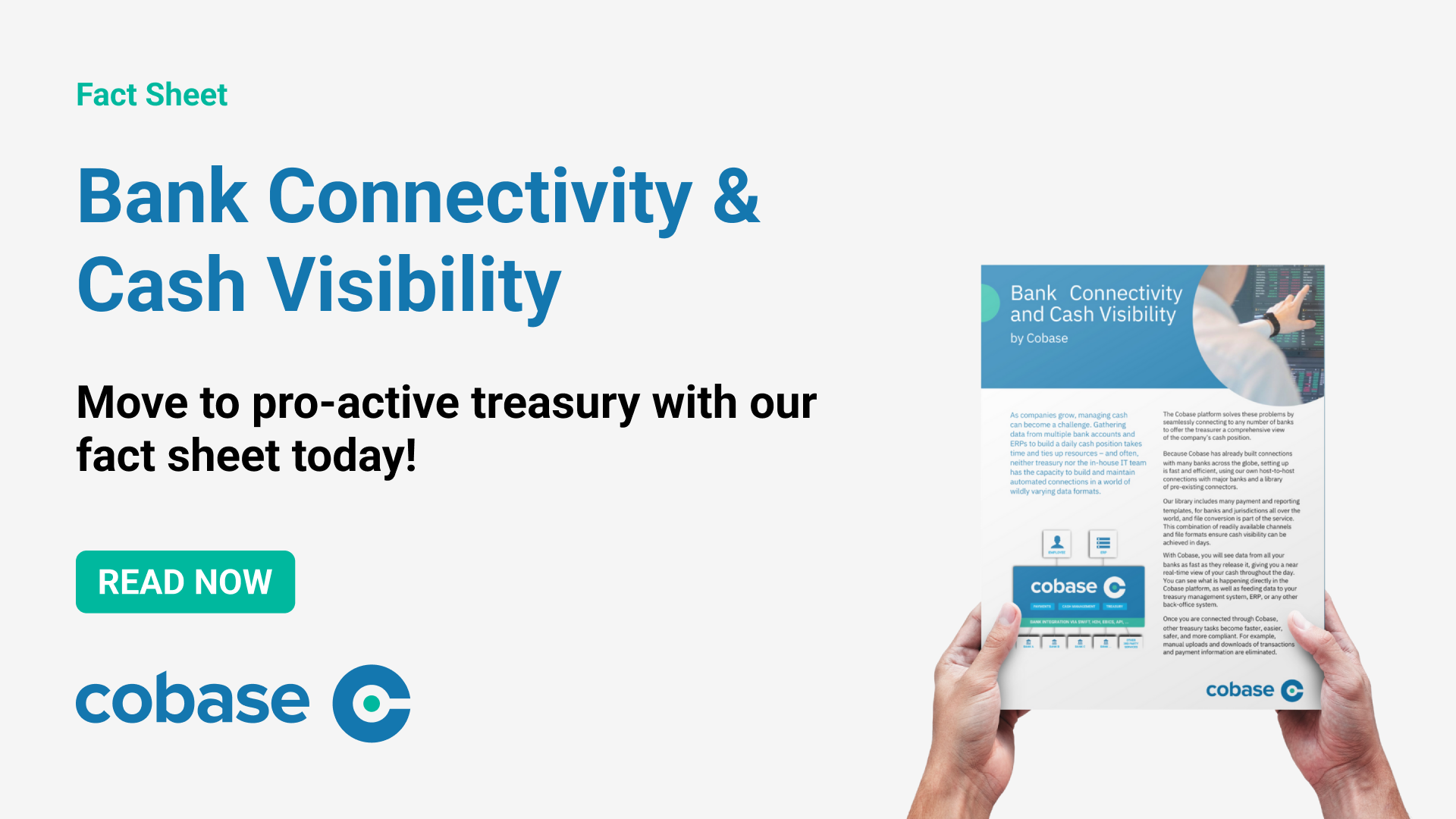Frontiers of Banking: Navigating APIs & PSD2 Protocols
In the modern corporate world, the efficiency of banking operations depends heavily on the communication protocols used to connect with financial institutions. In this extensive comparison, we delve into the nuances of various protocols like SWIFT FIN, SWIFT FileAct, Host-to-Host, EBICS (versions 2.4, 2.5, and 3.0), APIs, and PSD2, examining their strengths and weaknesses. In this blogpost we will focus on APIs & PSD2.
APIsAPIs, short for Application Programming Interface, play a vital role in today's interconnected digital ecosystem. They enable different software systems to communicate with each other seamlessly and efficiently. Within the banking context, APIs provide a mechanism for banks to expose their services to corporates, facilitating direct integration with corporate systems.
One of the main strengths of APIs lies in their ability to provide real-time or near-real-time access to banking services. Corporates can make API calls to check account balances, initiate payments, or fetch transaction history, receiving immediate responses. This allows corporates to have an accurate, up-to-the-minute view of their financial position and to execute transactions without delay.
APIs also provide a high level of flexibility and customization. They can support a wide range of services and functionality, depending on the banks' chosen level of exposure. Moreover, APIs can be designed to handle complex banking operations, like bulk payments or multi-step approval workflows, offering corporates the flexibility to tailor banking interactions to their specific needs.
Another significant benefit of APIs is their potential for improving operational efficiency. By integrating directly with corporate systems, They can help automate banking processes, reducing manual intervention and associated errors.
However, the use of APIs also brings certain challenges. A key concern is the technical complexity associated with their implementation. Each interface has its own specific requirements in terms of the request format, response handling, error handling, etc. Corporates need to ensure their systems are compatible with these requirements, which often demand significant IT effort and expertise.
Security is another critical consideration. APIs essentially provide a gateway into the bank's system, and improper implementation can lead to significant security vulnerabilities. Corporates need to ensure robust security measures, such as encryption, authentication, and access controls, are in place when using them.
Moreover, the availability and functionality of APIs are entirely dependent on the bank. Not all banks may offer APIs, and even among those that do, the range of services exposed via APIs can vary widely.
In conclusion, APIs offer a powerful and flexible mechanism for corporates to interact directly with their banks, providing real-time access to banking services and the potential for improved operational efficiency. However, corporates need to navigate the challenges of technical complexity, security, and variability in bank API offerings to harness the full potential of APIs for banking communication.
Strengths:
- Efficiency: APIs provide direct, real-time access to banking services, making transactions efficient.
- Flexibility: APIs can support a wide range of banking services based on the bank's offerings.
Weaknesses:
- Security Concerns: While APIs can be secure, the direct connection to the bank's systems necessitates robust security measures.
- Bank Dependence: The availability of APIs depends on each bank's technical capabilities and willingness to expose their services.
PSD2
The Second Payment Services Directive (PSD2) is a transformative regulation implemented by the European Union to foster innovation and competition within the financial sector. PSD2 mandates that banks provide third-party providers (TPPs) with access to their customers' accounts through APIs, provided the customer has given explicit consent. This is often referred to as 'open banking'.
This directive effectively shifts the control of financial data from banks to consumers, empowering them to use third-party services for managing their finances. For corporates, PSD2 presents an exciting opportunity to directly access banking services and improve financial operations.
One of the main strengths of PSD2 is that it paves the way for real-time access to banking services. Corporates can utilize APIs to fetch account information, initiate payments, and access other banking services in real-time. This not only enhances visibility into their financial standing but also speeds up transactions and decision-making processes.
Another significant advantage of PSD2 is the potential for innovation. By opening up banking data, PSD2 has spurred the development of new financial services and solutions. This can lead to more efficient banking processes, cost savings, and better financial management.
PSD2 also lays down stringent security measures for financial transactions. It introduces strong customer authentication (SCA) requirements, which mandate two-factor authentication for most electronic payments, thereby reducing the risk of fraudulent transactions.
Despite its potential benefits, there are also associated challenges. One of the major concerns is data privacy and security. While the regulation has strict guidelines for customer authentication and data protection, sharing financial data with third parties inevitably increases the risk of data breaches.
Furthermore, the technical implementation of PSD2 APIs can be complex. Corporates need to ensure that their systems are compatible with the APIs of different banks, each of which might have unique requirements.
Also, PSD2 is applicable only to banks operating within the European Economic Area (EEA). Corporates with banking relationships outside of the EEA might not be able to leverage the benefits of PSD2 with those banks.
PSD2 is a ground-breaking regulation that has the potential to significantly improve the way corporates interact with their banks. The benefits of real-time access to banking services and the potential for innovative financial solutions must be weighed against the challenges of data security, technical complexity, and geographical limitations.
Strengths:
- Innovation: By mandating banks to provide APIs, PSD2 aims to foster competition and innovation in the banking sector.
- Enhanced Access: PSD2 has the potential to greatly enhance corporates' access to banking services, improving efficiency and customer experience.
Weaknesses:
- Limited Scope: PSD2 only applies to European banks, which can limit its usefulness for corporates with global operations.
- Technical Challenges: Similar to other APIs, implementing and using PSD2 APIs can be technically challenging, and security is a critical concern.
Unique challenges
While all these protocols offer diverse strengths, they also come with their unique challenges. Corporates must carefully assess their specific requirements, technical capabilities, security needs, and the geographical scope of their banking relationships before choosing the most suitable protocol. Consulting with financial and IT experts can help inform this crucial decision.
Navigating the labyrinth of banking protocols can be daunting, but there's a solution that simplifies it all - Cobase. With the ability to connect via all the protocols mentioned above, Cobase is a one-stop platform for corporates looking to streamline their banking communications.
One of the key strengths of Cobase is its deep, in-house knowledge across all banking protocols. Whether it's SWIFT FIN, FileAct, Host-to-Host, EBICS (2.4, 2.5, and 3.0), APIs, or PSD2, the technical experts at Cobase are well-versed in all. They take the burden off corporates to learn and implement these technical standards, allowing them to focus on their core business.
What's more, Cobase owns a financial BIC (Business Identifier Code), offering corporates the advantage of the SWIFT network without the need to set up and maintain their own SWIFT BIC. This means corporates can avoid the often costly and time-consuming process of acquiring a BIC and still reap the benefits of secure, standardized messaging and a globally recognized identity on the SWIFT network.
Published:




